As urban development continues to grow, the risk of surface water flooding also increases. This is because green spaces and permeable surfaces are often replaced with impermeable surfaces, such as concrete or tarmac, which prevents water from soaking into the ground. Sustainable drainage systems (SuDS) are designed to manage surface water close to where it falls, mimicking natural drainage as closely as possible. There are several types of SuDS, which work to manage the risk of flooding, whilst providing additional benefits for people, communities, and the environment.
Sustainable drainage systems, or ‘SuDS’, are ways of managing surface water locally by mimicking how water naturally drains through the environment. Unlike traditional drainage networks which rely on underground pipes and sewers, SuDS slow the flow of water and allow it to soak into the ground, be stored, or used by vegetation.
Sustainable drainage systems refer to a wide range of features that manage surface water in different ways. These can include rain gardens, swales, green roofs, permeable paving, detention basins, and more. SuDS can be integrated into gardens, housing developments, roadsides, and public spaces.

SuDS offer benefits such as:
Managing rainwater in you garden?
For information from the Royal Horticultural Society on how SuDS can manage waterlogging and flooding from your garden, click here.
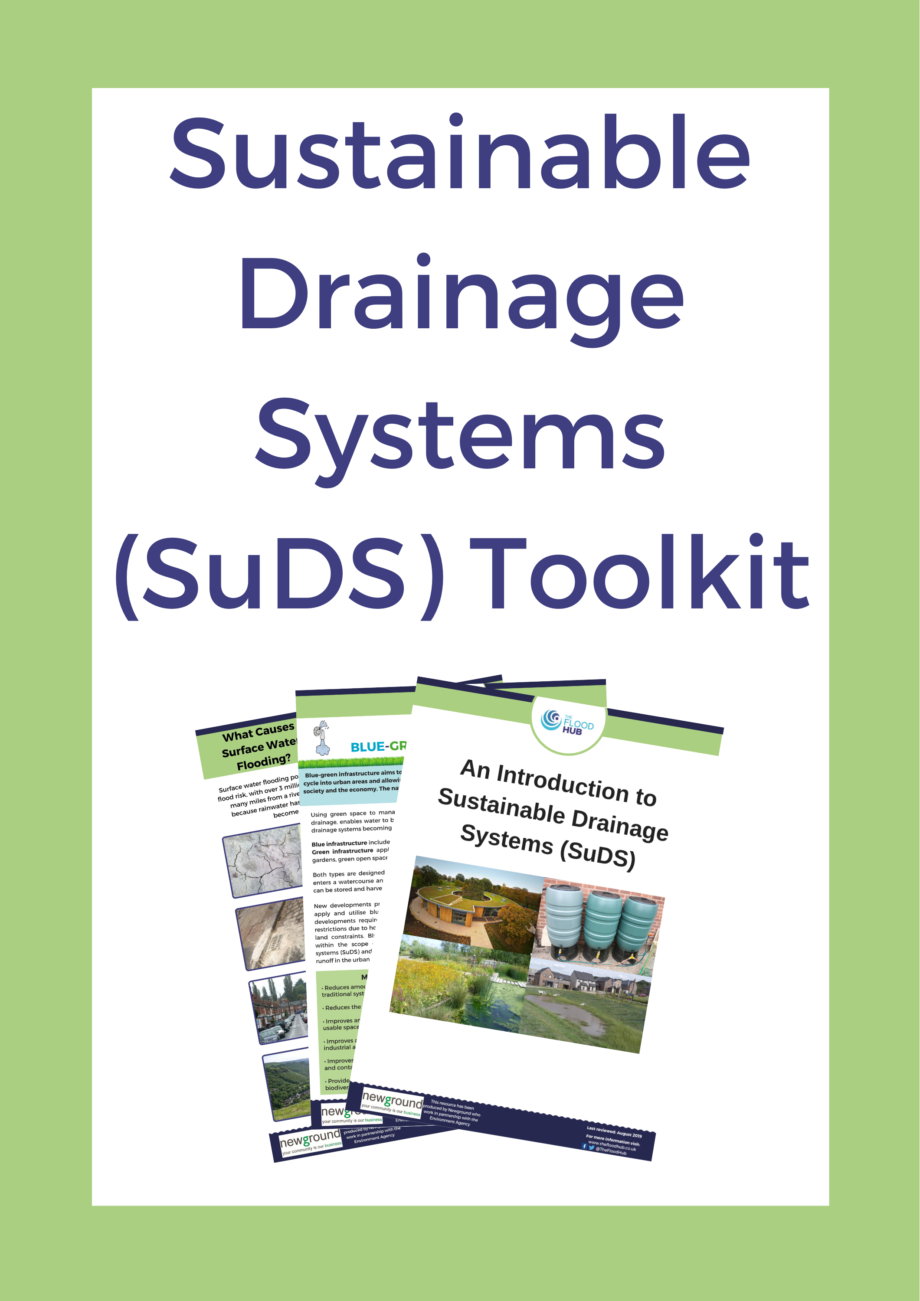
Explore our SuDS toolkit:
Click here to view our ‘Sustainable Drainage Systems (SuDS) Toolkit’ which contain a variety of resources and downloads to help you understand and implement SuDS.
Surface water flooding, also known as pluvial flooding, occurs when the volume of rainfall overwhelms the capacity of drains and sewers. When the excess rainfall cannot soak into the ground or flow away through drainage systems, and instead, flows over the land.
This type of flooding is often made worse by intense rainfall events, blocked road gullies or sewers, saturated and waterlogged ground and the presence of hard, impermeable surfaces which stop water from being absorbed into the ground.
If your property is at risk of surface water flooding, it’s important to understand the cause. This can help you choose the most suitable SuDS (Sustainable Drainage Systems) to manage the problem effectively.
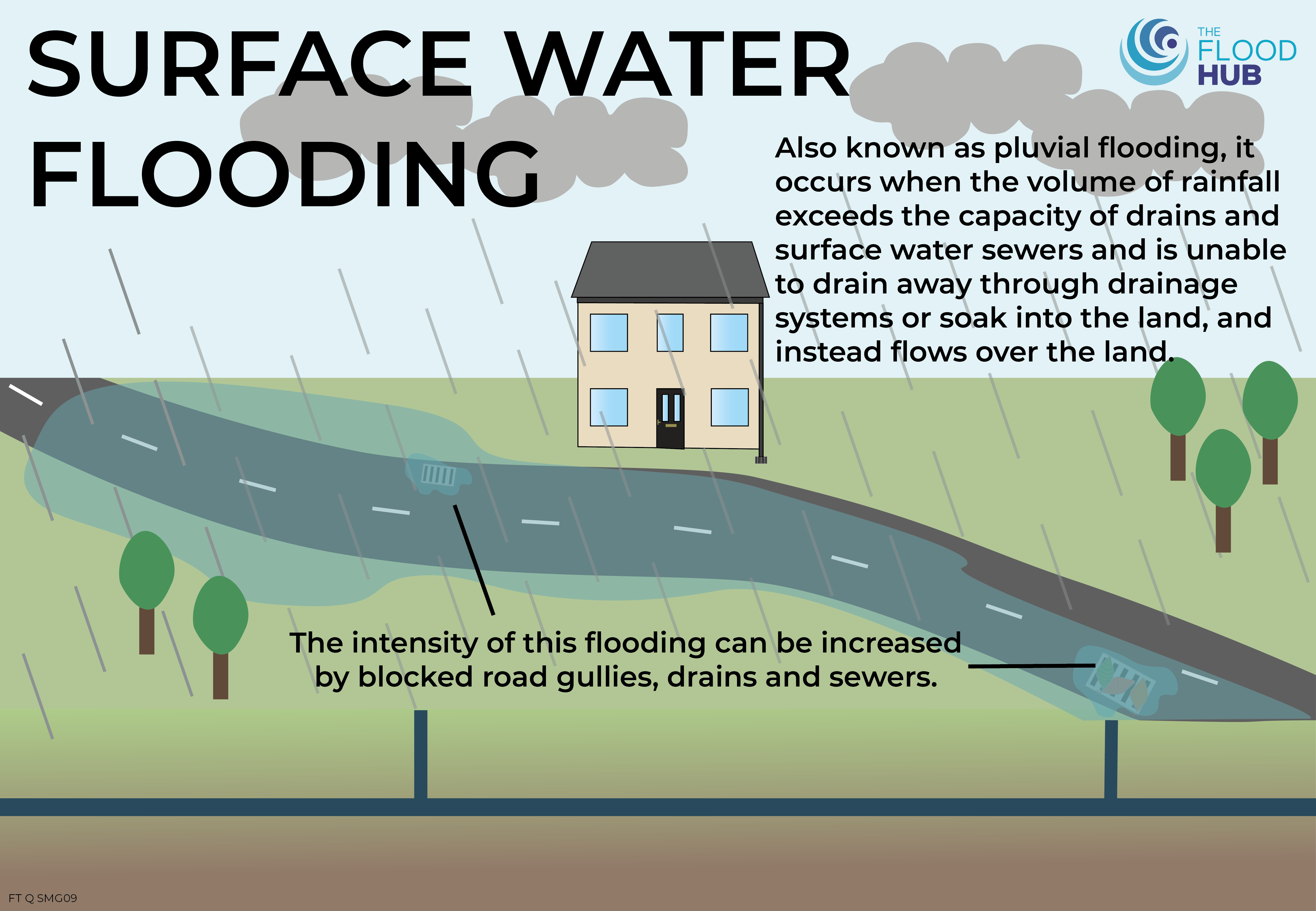
To learn more about surface water flooding, click here to view our toolkit, where you can find a number of useful resources:
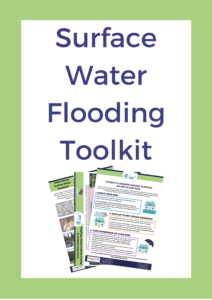
Bioretention strips are vegetated areas with sand and gravel layers beneath the surface. As rainwater falls on them, runoff either infiltrates through the layers or drains into a pipe which then carries the water elsewhere. The storage and diversion of rainwater can reduce peak runoff rates, helping to manage the risk of flooding. They are often found alongside roads, car parks or footpaths, where they help manage surface water runoff from hard surfaces.
During the infiltration process, the bioretention strips filter and cleanse the runoff from pollutants, nutrients, metals, suspended solids, and bacteria, improving the overall quality of the stored water. Bioretention strips have been used in the, GrowGreen Manchester Project as tree pits, which absorb the rainwater which falls on the footpath above them. Click here to read the case study.
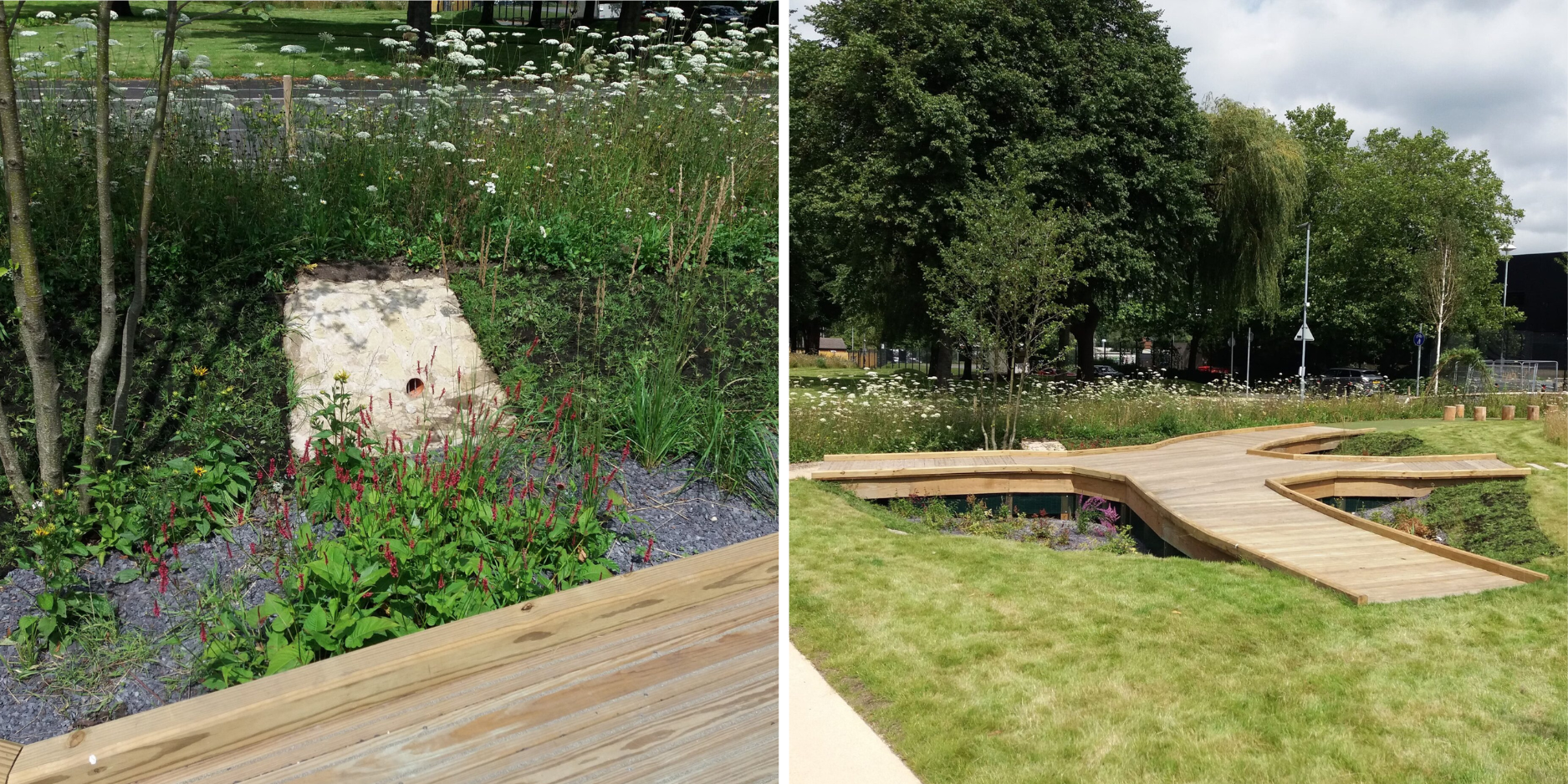
Detention basins are grassed areas that act as temporary storage basins and are commonly found in parks, public open spaces, or near housing developments. They are typically dry, except during storm events, when they store rainwater and surface water runoff before allowing it to slowly infiltrate into the ground, helping to manage the risk of flooding to the local area. They also filter the water to remove sediment and pollutants, improving overall water quality.
Detention basins not only help manage surface water but can be used as recreational spaces. When they fill with water during heavy rainfall, they create temporary wetland habitats that support wildlife and enhance biodiversity. During dry periods they remain empty and can be safely used for leisure activities like walking or play, making them a valuable community space all year round.
Retention ponds are areas of shallow, open water designed to store rainwater and regulate runoff at a controlled rate during and after a rainfall event. They differ from detention basins as they are intended to hold water permanently, with the water level rising temporarily during heavy rainfall to accommodate for more water.
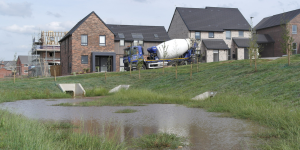
Green roofs, or ‘living roofs’, are roofs which are fully or partially covered with vegetation. They have a multi-layered system comprising of an impermeable layer, a drainage layer and a ‘living’ layer made up of plants and vegetation. The vegetation intercepts and stores rainwater to reduce the amount of runoff entering drains and sewers which can contribute to reducing flood risk. A green roof is typically low maintenance and can sometimes be used to replace a traditional roof on buildings such as garages or bus shelters.
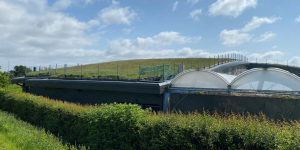
Permeable paving is an alternative to traditional concrete paving and allows for surface water runoff to infiltrate the ground, helping to manage surface water flood risk. Permeable paving either uses gaps between paving stones to allow water to run through, or the paving itself is made of a porous material that allows water to pass through. Other alternatives to paving which have the same effect include wood chippings or recycled aggregates. Surface water infiltrates through the soil below or enters a storage tank beneath the paving, where it can be slowly released.
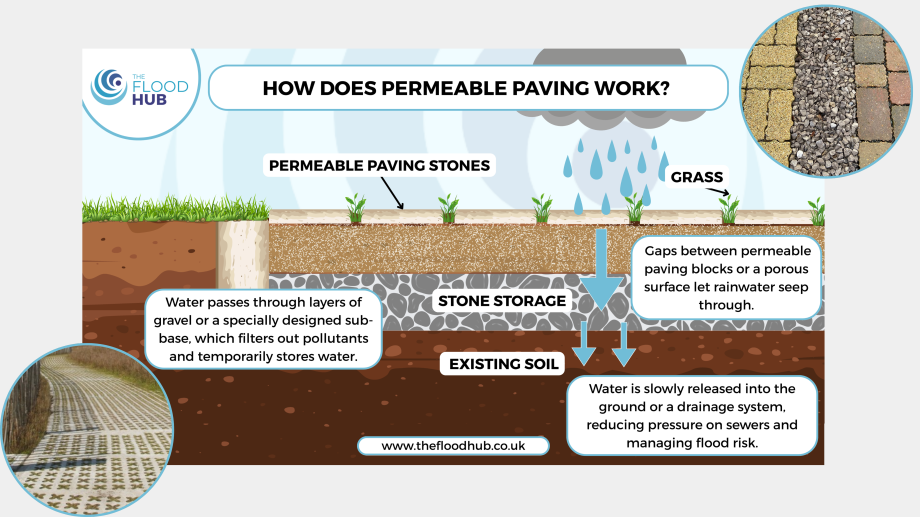
Rain gardens are shallow, vegetated depressions that can withstand temporary inundation of water for up to 48 hours. They receive surface water runoff from impermeable surfaces like roofs, driveways, and roads. Downpipes from roof gutters and channel drains can be redirected away from sewers and redirected into these gardens. A water accumulates and infiltrates through the soil, rain gardens help to reduce the rate of runoff and volumes of surface water. As the runoff infiltrates the ground, pollutants and sediments are filtered out which improves the water quality.

Rainwater harvesting involves collecting and storing rainwater that would usually flow into drains and sewers. Th collected water can be re-used in homes and gardens for purposes such as, irrigation, toilet flushing and gardening.
Water butts are a common rainwater harvesting option which can easily be retrofitted to properties. They can be fitted to the downpipe of a building to collect the water which falls onto the building’s roof. When full, excess water is redirected back into the drainpipe to the drainage network as normal. A small tap located at the bottom of the water butt allows access to the stored water.
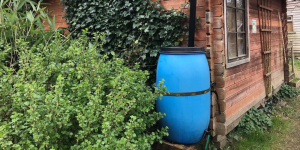
Underground tanks, geocellular structures, or plastic crates can also be used for storing rainwater. These systems often require excavation and space beneath surfaces such as car parks, roads, or private gardens. These systems can help convey and infiltrate water to reduce peak flows, supporting natural drainage. Only a certain amount can be discharged back into the environment to manage the risk of flooding.
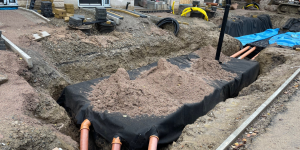
Swales are shallow, broad, vegetated channels that temporary store, slow down and direct stormwater runoff to reduce peak flows in watercourses and drainage systems. As water flows into the swale, the broad, shallow channel slows down its movement, allowing the water to spread out and giving it more time to infiltrate into the soil. This reduces the amount of runoff reaching nearby drains and watercourses.
Swales can be ‘wet’ and store water above ground in the channel, or ‘dry’ where water collects in a pipe or gravel layer beneath. In wet weather, rainwater flows down the sloped sides and into the swale channel, where it infiltrates through the vegetation, which filters sediment and pollutants. Some of the runoff is also lost at the surface through evapotranspiration, further reducing peak flow and improving water quality.
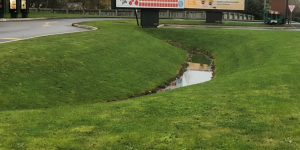
Wetlands are similar to retention ponds but are shallower and filled mostly with marshy, aquatic vegetation. Wetland areas help attenuate and slow the flow of rainwater runoff, by absorbing and holding water, managing the risk of local watercourses and drainage networks. The plants and soil filter the water and improving its quality before it enters local watercourses. They remove fine sediments, dissolved nutrients, metals and particulates from the water by filtration through the vegetation and aerobic decomposition.
Naturally occurring wetlands can be found in floodplains, riverbanks, and coastal areas, but they can also be created in urban and rural environments for flood management. In addition to managing surface water, wetlands support biodiversity by providing habitats for a variety of wildlife. These areas are also valuable for recreation and education, allowing people to engage with nature and learn about local ecosystems.
Blue-green infrastructure refers to the combination of natural green areas like parks and woodlands, and blue features such as ponds, rivers, and swales in urban spaces. Together, they help manage flood risk, while enhancing urban areas for people and wildlife.
It aims to manage the risk of flooding whilst helping to restore a more natural water cycle into urban environments, where it is previously disrupted by impermeable surfaces. In natural environments, water is absorbed into the ground (infiltration), evaporates into the atmosphere (evaporation), or flows slowly into water bodies. This reduces surface water runoff and helps manage rainfall sustainably. By mimicking this natural process through blue-green infrastructure, urban areas can become more resilient, while providing land that benefits the environment, society and the economy.
Blue-green infrastructure can provide many benefits and ecosystem services, such as:
With climate change and urban growth putting increasing pressure on drainage networks, blue-green infrastructure will be crucial to the wellbeing of our communities. These features help prevent traditional drainage systems becoming overwhelmed, managing flood risk. At the same time, they create greener, more attractive, and more usable public spaces.
Download this ‘Blue-green Infrastructure’ resource here.
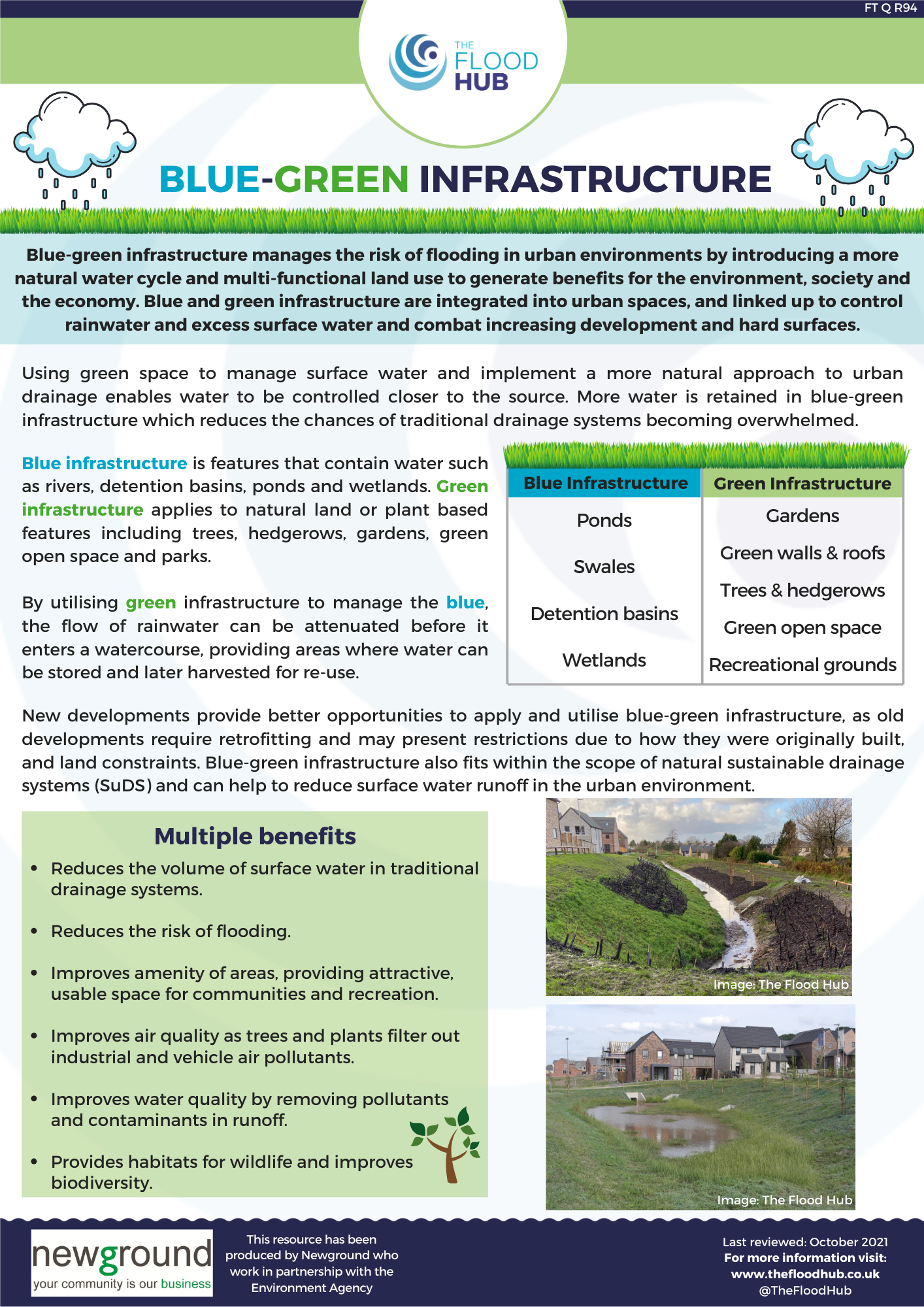
Sustainable drainage systems (SuDS) often provide a range of benefits to people and the environment, from managing flood risk to improving water quality and increasing biodiversity.
Hover over each benefit below to explore the multiple benefits of SuDS. You can also find this information below the image or by clicking the benefits within the menu on the left-hand side of this page.
You can download the full resource with explanations here.
SuDS are designed to mimic or replicate natural drainage processes, which reduces the volume of runoff and rainwater reaching drains and watercourses. They provide areas to store water and slow the flow of water to manage flood risk in urban areas. SuDS techniques, such as permeable pavements, swales, and detention basins, help to slow and absorb excess rainwater, reducing the likelihood of surface water flooding. By reducing the volume and speed of water flowing into stormwater drains and watercourses, they alleviate pressure on traditional drainage systems, which can become overwhelmed during heavy rainfall.
In addition, SuDS can provide temporary water storage during extreme weather events, allowing rainwater to infiltrate the ground slowly or be stored in ponds, wetlands, or other features. This controlled release of water helps to reduce the risk of downstream flooding and protects both infrastructure and property.
SuDS, such as water butts, can collect and store water all year round, which can be reused during the summer and in periods of drought for numerous different purposes, such as toilet flushing, irrigation, or watering plants. Not only is this better for the environment in terms of water availability and usage, but it can also help to reduce your household’s water bills. Additionally, using rainwater preserve clean, treated water for essential needs, ensuring more efficient and sustainable water usage.
Using SuDS such as rain gardens, detention basins, wetlands and retention ponds can help to maintain, link and create new habitats to support existing and new wildlife. These systems can increase the biodiversity in urban and suburban areas by providing essential green spaces where plants, insects, birds, and other animals can thrive. In particular, wetlands and ponds offer crucial habitats for amphibians, birds, and aquatic species, while rain gardens and green roofs provide spaces for pollinators like bees and butterflies.
SuDS can also be used as an educational resource for local schools and nurseries, allowing children to observe different plant and animal species which they may not have had the opportunity to so otherwise, especially if the school is in an urban area.
SuDS can enhance the physical and mental health and well-being of communities by providing accessible green spaces that encourage activities such as walking, cycling and organised sports. These green spaces serve as vital recreational areas, offering people the opportunity to engage in physical activity, relax, and connect with nature. The presence of parks, green roofs, and green walls not only promotes an active lifestyle but also helps promote a sense of community and social interaction.
Moreover, some SuDS measures, like green infrastructure or swales can improve the air quality of an area as they absorb or remove pollutants, including nitrogen dioxide (NO2), sulphur dioxide (SO2), particulates (PM10) and ozone (O3). By reducing air pollution, SuDS create healthier environments that lower the risk of respiratory conditions and improve overall public health.
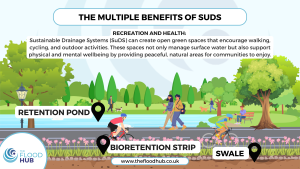
Large, open spaces with more trees and plants can make an area more attractive and pleasant to live work and visit especially in urban areas and city centres where green space is often limited. These improvements in the look and feel of a place can encourage more people to spend time there, attracting visitors and boosting local businesses. Greener, more appealing areas can also increase property and land values, supporting the local economy and encouraging investment.
As rainwater filters through SuDS, it passes a layer of vegetation, soil, and other natural materials that help remove fine sediments, nutrients, metals and other pollutants from runoff which improves the water quality.
In addition to filtering pollutants, SuDS also intercept rainfall and slow the flow of water, reducing the volume that enters sewers and drainage systems. This helps to lower the risk of combined sewer overflow and the amount that needs treating, reducing the pressure on traditional drainage systems
The vegetation and plants used in SuDS such as green roofs, can help capture and store carbon and other greenhouse gases, improving air quality. They can also help to reduce both air and water pollution. In addition, by providing natural insulation, SuDS features such as green roofs and walls regulate building temperatures, helping to lower energy use and help reduce the urban heat island effect.
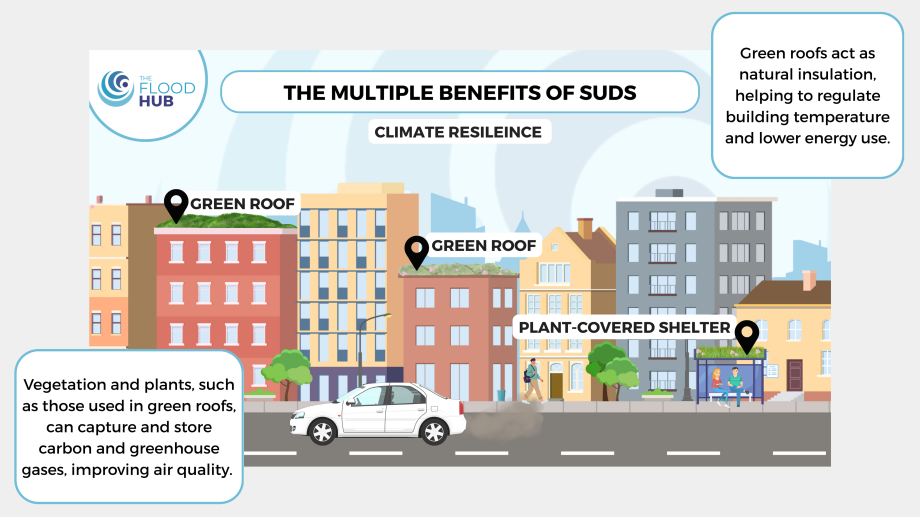
Under the National Planning Policy Framework, SuDS should be provided on all major developments (these include ten or more homes, or on areas of 0.5 hectares or more), and in areas at risk of flooding unless demonstrated to be inappropriate (for example, mineral extraction development), and the techniques used will depend on site-specific characteristics.
For more information, please visit our Planning and Development page here.
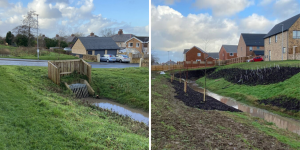
Click on the links below to download the case studies which are great examples of how SuDS have been used across the North West.
The Crossens solar-powered pumping station project is a regional first for the Environment Agency (EA). The station will be powered by solar energy with surplus energy produced. This energy will be stored for future use across EA infrastructure. The station will continue to reduce flood risk to 660 homes and farmland.
United Utilities are responsible for managing and slowing rainwater surface runoff, which they do by installing Sustainable Drainage Systems, otherwise known as SuDS. SuDS can slow rainwater runoff by mimicking natural drainage through interception, infiltration and evapotranspiration, which can help manage a catchment’s flood risk. SuDS are a vital part of United Utilities’ wider Catchment Systems Thinking (CaST) approach, which manages the catchment in a more holistic and integrated way and also considers the environment and people together.
Blue-green infrastructure acts as multi-functional sustainable systems which encourage water to flow more naturally by mimicking natural drainage. In turn, blue-green infrastructure reduces the demand on the drainage network by slowing and storing rainwater which would run off into the sewer network. Blue-green infrastructure incorporates green spaces, which are vegetation-based features such as trees, hedgerows, permeable paving, and water-based blue features such as ponds, wetlands and floodplains. The benefit of installing blue-green infrastructure is that natural drainage is improved, which manages surface runoff more effectively than traditional grey infrastructure, therefore reducing flood risk.
Click here to visit the Unpave the Way project page. Unpave the Way is an innovative project between the North West Regional Flood and Coastal Committee (North West Regional Flood and Coastal Committee | The Flood Hub), the Environment Agency, United Utilities, and Lancashire County Council which aims to inspire greener gardens through Sustainable Drainage System methods like permeable paving and rainwater harvesting.
United Utilities created a SuDS ‘slow the flow’ garden for RHS Tatton Show, which is shown in the video below. It featured permeable paving, rainwater harvesting tanks, a green roof, bioretention strips and permeable concrete walkways.
Watch United Utilities video above for a tour of the Slow the Flow garden.
Gardens play a vital role in managing the risk of surface water flooding, and FloodRe’s The Flood Resilient Garden will showcase how specially chosen landscaping and planting features can respond and adapt to heavy rainfall and surface water flooding. The project garden was shown at Chelsea Flower Show 2024.
Click here to find out more about FloodRe’s The Flood Resilient Garden. You can view The Flood Resilient Garden’s Instagram page here.